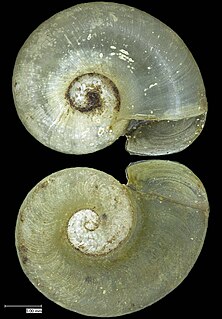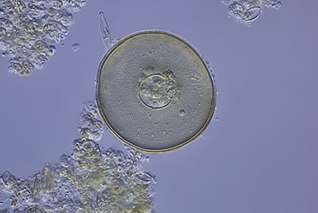
The centrohelids or centroheliozoa are a large group of heliozoan protists. They include both mobile and sessile forms, found in freshwater and marine environments, especially at some depth.

Hemidactylus is a genus of the common gecko family, Gekkonidae. It has 176 described species, newfound ones being described every few years. These geckos are found in all the tropical regions of the world, extending into the subtropical parts of Africa and Europe. They excel in colonizing oceanic islands by rafting on flotsam, and are for example found across most of Polynesia. In some archipelagoes, cryptic species complexes are found. Geckos like to live in and out of houses. They have been introduced to Australia.

Pelomyxa is a genus of giant flagellar amoebae, usually 500-800 μm but occasionally up to 5 mm in length, found in anaerobic or microaerobic bottom sediments of stagnant freshwater ponds or slow-moving streams.

The Archamoebae are a group of protists originally thought to have evolved before the acquisition of mitochondria by eukaryotes. They include genera that are internal parasites or commensals of animals. A few species are human pathogens, causing diseases such as amoebic dysentery. The other genera of archamoebae live in freshwater habitats and are unusual among amoebae in possessing flagella. Most have a single nucleus and flagellum, but the giant amoeba Pelomyxa has many of each.
Awaous is a genus of fish in the family Gobiidae, the gobies. They are native to fresh, marine and brackish waters from Africa to the Americas.

Thyrophorella is a genus of small, air-breathing land snails, terrestrial pulmonate gastropod mollusks in the family Achatinidae.
Werner Greeff is a former South African rugby union player. He played for Western Province in the Currie Cup and for the Stormers in the Super 14 until a neck injury forced him into retirement in January 2007. Greeff also played 12 Tests for South Africa.

Thyrophorellinae is a subfamily of small air-breathing land snails, terrestrial pulmonate gastropod mollusks in the family Achatinidae.

Nuclearia is a nucleariid genus.

Arcella is a genus of testate amoebae in the order Arcellinida, usually found in freshwaters and mosses, and rarely in soils. A key characteristic of Arcella is the circular test with a hole on its center from where finger-like pseudopods emerge. It is one of the largest testacean genera.

Testate amoebae are a polyphyletic group of unicellular amoeboid protists, which differ from naked amoebae in the presence of a test that partially encloses the cell, with an aperture from which the pseudopodia emerge, that provides the amoeba with shelter from predators and environmental conditions.

Thecamoebais a genus of Amoebozoa with a tough pellicle simulating a shell.
Carel Frederick Kirstein Greeff is a South African rugby union player, currently playing with Italian Top12 side Rugby Rovigo Delta. His regular position is loose-forward.

Sicydium is a genus of gobies native to fast-flowing streams and rivers of the Americas with a couple species native to Middle Africa.
Richard Greeff was a German zoologist.
Greeff's giant gecko is a species of gecko, a lizard in the family Gekkonidae. The species is found on islands in the Gulf of Guinea off the east coast of Africa.

Echinoderes is a genus of mud dragons first described in 1863. It is the largest genus within class Kinorhyncha. It is a highly diverse genus, with member species that inhabit "most marine benthic substrates, on latitudes ranging from the Arctic to the tropics, and from the intertidal zone down to the deep sea." Species on the east coasts of North and South America have been extensively studied by Robert P. Higgins. Species in east Asia have been extensively studied by A. V. Adrianov.
Anelassorhynchus is a genus of spoonworms in the subclass Echiura.
Nemertoscolex is a genus of ribbon worms belonging to the family Lineidae.
Protohydridae is a family of cnidarians belonging to the order Anthoathecata.











